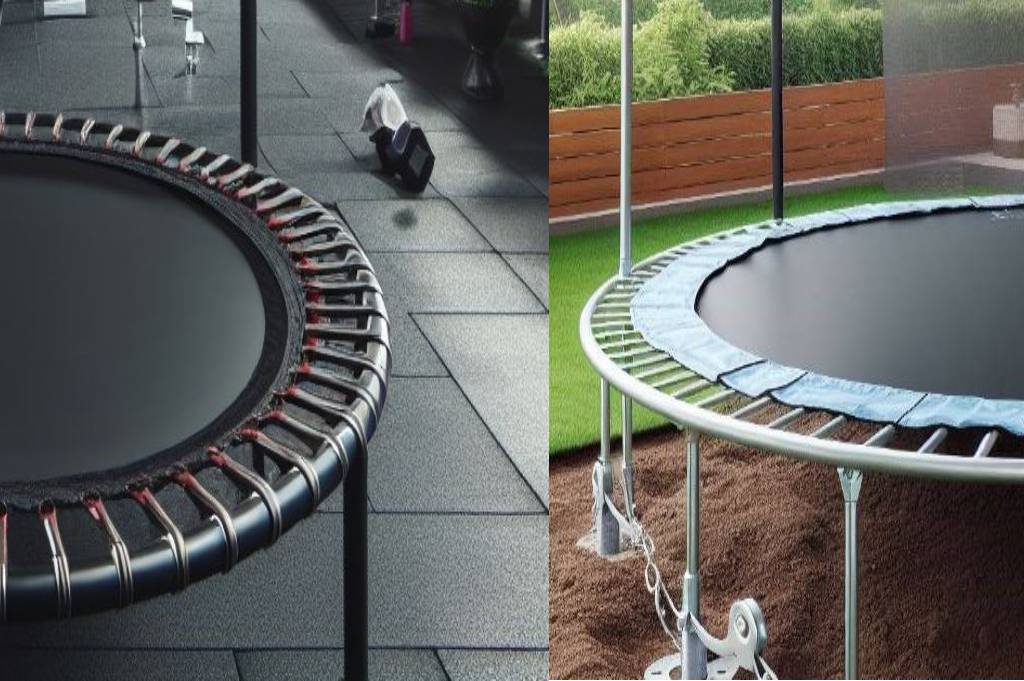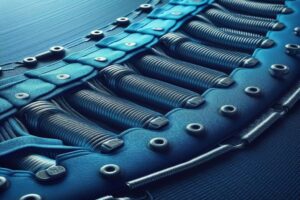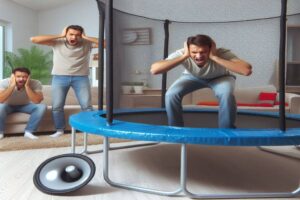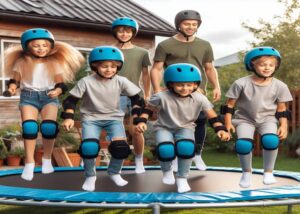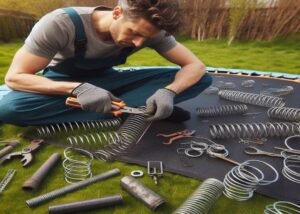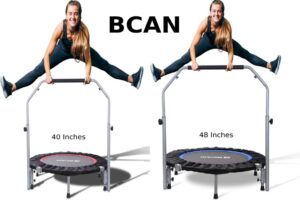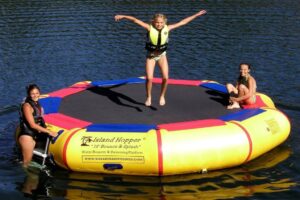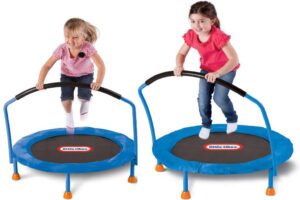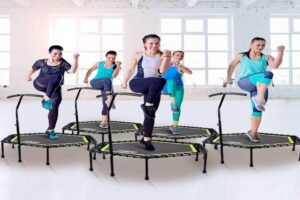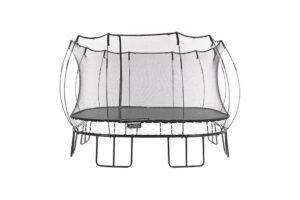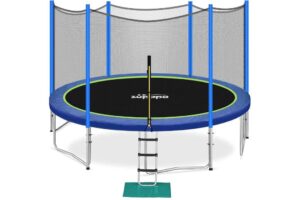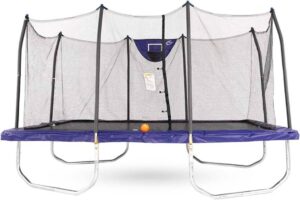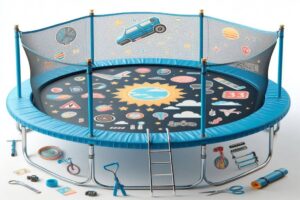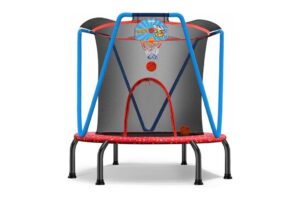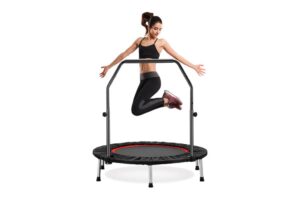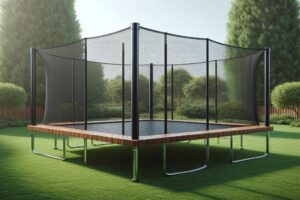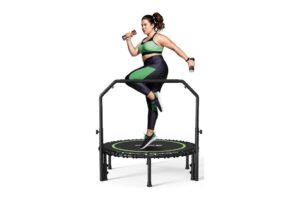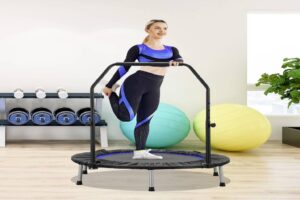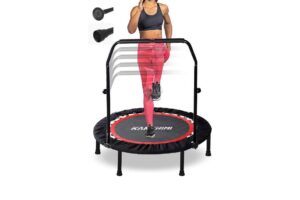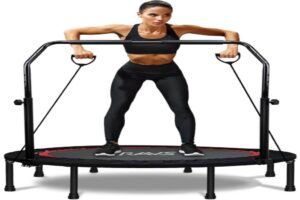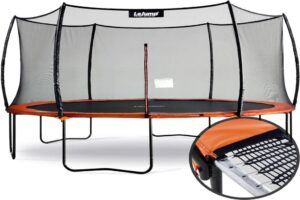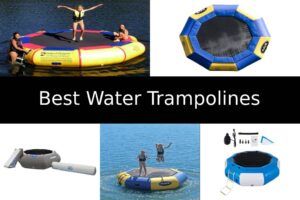Introduction
Bungee Cord Trampolines vs. Spring Trampolines
Trampolines have become a pivotal in many households, offering hours of entertainment and exercise for both children and adults alike. However, with the variety of trampoline options available on the market, choosing the right one can be a daunting task. Here, we’ll delve into the differences between two popular types of trampolines: bungee cord trampolines vs. spring trampolines. But before we jump into the comparison, let’s start with a brief overview of trampolines and discuss the importance of selecting the perfect trampoline for your needs.
Brief Overview of Trampolines
Trampolines consist of a strong, flexible fabric stretched taut over a steel frame, supported by either bungee cords or metal springs. When a person jumps on the trampoline mat, the fabric stretches, storing potential energy. Upon landing, this energy is released, propelling the jumper upwards in a bouncing motion.
Trampolines come in various shapes and sizes, including round, rectangular, and oval, catering to different preferences and available space. Additionally, they can be used for recreational purposes, fitness training, or even professional gymnastics.
Importance of Choosing the Right Trampoline
Selecting the right trampoline is crucial for ensuring safety, durability, and enjoyment. Here are some key reasons why choosing the perfect trampoline matters:
- Safety: Safety should always be the top priority when selecting a trampoline. Factors such as enclosure design, padding quality, and stability play a significant role in minimizing the risk of injuries, especially for children.
- Durability: Investing in a durable trampoline ensures that it can withstand regular use, varying weather conditions, and the test of time. High-quality materials and sturdy construction contribute to the longevity of the trampoline.
- Bounce Quality: The bounce quality of a trampoline affects the overall experience of the user. Factors such as spring tension or bungee cord elasticity determine the responsiveness and consistency of the bounce.
- User Experience: The right trampoline should provide an enjoyable experience for users of all ages and skill levels. Whether it’s for recreational jumping, fitness workouts, or advanced tricks, the trampoline should meet the needs and preferences of the intended users.
- Value for Money: Purchasing a trampoline is an investment, and it’s essential to get the best value for your money. Considering factors such as price, features, and long-term maintenance costs can help ensure that you’re making a worthwhile investment.
By understanding the basics of trampolines and recognizing the importance of choosing the right one, you can make an informed decision that suits your needs and preferences. In the following parts, we’ll delve deeper into the comparison between bungee cord trampolines vs. spring trampolines, helping you determine which type is the perfect fit for you.
Bungee Cord Trampoline: How It Works
Bungee Cord Trampolines vs. Spring Trampolines
When it comes to selecting the perfect trampoline, understanding the mechanics behind each type is crucial. Let’s start by delving into the inner workings of bungee cord trampolines.
Description of Bungee Cord Trampoline
Bungee cord trampolines utilize elastic cords as the primary mechanism for providing bounce. These cords, often made of high-quality rubber or synthetic materials, are strategically attached to the trampoline frame and stretched across the mat surface.
The elasticity of the bungee cords allows them to absorb and store energy when a user jumps on the trampoline. Upon landing, the cords release this stored energy, propelling the jumper upwards in a controlled and responsive manner. This mechanism offers a smoother, more consistent bounce compared to traditional spring trampolines.
Advantages of Bungee Cord Trampolines
- Enhanced Safety: Bungee cord trampolines are designed to minimize the risk of injuries, thanks to their gentle and controlled bounce. The elasticity of the cords reduces the impact on joints and muscles, making them ideal for users of all ages and skill levels.
- Responsive Bounce: The bungee cord mechanism provides a highly responsive bounce, allowing for precise control and maneuverability. This makes bungee cord trampolines well-suited for recreational jumping, fitness workouts, and even advanced gymnastics routines.
- Quiet Operation: Unlike spring trampolines, which may produce squeaking or creaking noises during use, bungee cord trampolines operate silently. This makes them ideal for environments where noise levels need to be kept to a minimum, such as residential neighborhoods or shared backyard space.
Drawbacks of Bungee Cord Trampolines
- Limited Weight Capacity: Bungee cord trampolines may have a lower weight capacity compared to spring trampolines. While they can typically support the average user without issue, heavier individuals or multiple users simultaneously may exceed the weight limit.
- Durability Concerns: Over time, the elasticity of bungee cords may degrade due to exposure to UV rays, temperature fluctuations, and general wear and tear. Regular inspection and maintenance are essential to ensure optimal performance and safety.
- Higher Initial Cost: Bungee cord trampolines often come with a higher upfront cost compared to traditional spring trampolines. However, many users find that the benefits of enhanced safety, bounce quality, and longevity justify the initial investment.
In conclusion, bungee cord trampolines offer a unique and innovative alternative to traditional spring trampolines. Their advanced mechanism provides a safer, more responsive bounce, making them an excellent choice for families, fitness enthusiasts, and aspiring gymnasts alike. While they may have some limitations, the advantages they offer often outweigh the drawbacks, making them a worthwhile investment for anyone looking to elevate their trampoline experience.
Spring Trampoline: Exploring Its Mechanism
Bungee Cord Trampolines vs. Spring Trampolines
In the world of trampolines, the spring trampoline stands as a classic choice. Let’s delve into the inner workings of this beloved trampoline type and uncover its unique characteristics.
Explanation of Spring Trampoline Design
Spring trampolines rely on coiled metal springs as the primary mechanism for generating bounce. These springs are securely attached to the trampoline frame, creating tension when the trampoline mat is stretched over them.
When a user jumps on the trampoline, the springs compress and store potential energy. Upon landing, this stored energy is released, propelling the jumper upwards in a dynamic and exhilarating bounce. The arrangement and tension of the springs play a crucial role in determining the trampoline’s performance and bounce quality.
Benefits of Using Spring Trampolines
- Dynamic Bounce: Spring trampolines offer a lively and energetic bounce, making them perfect for users who enjoy a more exhilarating jumping experience. The responsive nature of the springs allows for higher jumps and impressive acrobatic manoeuvres.
- Robust Construction: With their sturdy steel frame and durable metal springs, spring trampolines are built to withstand years of rigorous use. They can endure the elements, frequent jumping sessions, and the test of time, providing long-lasting enjoyment for users of all ages.
- Wide Availability: Spring trampolines are widely available in various shapes, sizes, and price ranges, making them accessible to a broad range of consumers. Whether you’re looking for a compact trampoline for your backyard or a large, commercial-grade model for a fitness facility, there’s a spring trampoline to suit your needs.
Limitations Associated with Spring Trampolines
- Potential Safety Concerns: While spring trampolines offer an exciting bounce experience, they may pose a higher risk of injuries compared to bungee cord trampolines. The exposed metal springs can cause pinching or entrapment injuries if users land too close to the edge of the trampoline or fall between the springs.
- Maintenance Requirements: Maintaining a spring trampoline may require regular inspection and maintenance to ensure optimal performance and safety. This includes checking for loose or damaged springs, applying lubrication to prevent rust, and replacing worn components as needed.
- Noise Level: The metal springs of spring trampolines may produce audible squeaking or creaking noises during use, particularly as the trampoline ages. While this may not be a significant issue for some users, it can be a consideration for those who prefer a quieter bouncing experience.
In conclusion, spring trampolines offer a dynamic and exhilarating bounce experience, coupled with robust construction and wide availability. However, it’s essential to be mindful of potential safety concerns and maintenance requirements associated with this trampoline type. By understanding the mechanics, benefits, and limitations of spring trampolines, you can make an informed decision that aligns with your preferences and needs.
Safety Features
Bungee Cord Trampolines vs. Spring Trampolines
When it comes to trampolines, safety is paramount. Let’s explore how bungee cord trampolines vs. spring trampolines address safety concerns through their design and features.
Analysis of Safety Enclosures
Both bungee cord trampolines and spring trampolines often come equipped with safety enclosures to prevent falls and injuries. These enclosures typically consist of a netting system that surrounds the jumping area, creating a barrier between the user and the ground.
Bungee cord trampolines may integrate the safety enclosure directly into the design, with the bungee cords themselves serving as part of the enclosure system. The elasticity of the cords allows them to act as a flexible barrier, minimizing the risk of users falling off the trampoline.
In contrast, spring trampolines typically utilize a frame-mounted safety enclosure, which attaches to the trampoline frame and forms a protective barrier around the jumping surface. The netting is suspended from the frame, providing a secure enclosure that prevents users from falling off the trampoline.
Impact Absorption
Evaluation of impact absorption is crucial in assessing the safety of bungee cord trampolines vs. spring trampolines. Upon landing, the trampoline should absorb impact effectively to reduce the risk of injury to the user.
Bungee cord trampolines excel in impact absorption due to the elastic nature of the bungee cords. When a user jumps and lands on the trampoline mat, the bungee cords stretch and flex, absorbing much of the impact and providing a softer landing compared to traditional springs.
Spring trampolines also offer adequate impact absorption, thanks to the compression and rebound of the metal springs. As the springs compress upon landing, they absorb energy, reducing the force exerted on the user’s body. However, the impact absorption may vary depending on the tension and quality of the springs.
In conclusion, both bungee cord trampolines and spring trampolines prioritize safety through the integration of safety enclosures and effective impact absorption mechanisms. While bungee cord trampolines may offer a more flexible and responsive safety enclosure due to the nature of the bungee cords, spring trampolines provide reliable impact absorption through their spring mechanism. Ultimately, choosing the right trampoline type depends on factors such as personal preference, budget, and specific safety considerations.
Durability and Longevity
Bungee Cord Trampolines vs. Spring Trampolines
When investing in a trampoline, durability and longevity are key considerations. Let’s dive into how bungee cord trampolines vs. spring trampolines stack up in terms of their construction materials and resistance to wear and tear.
Material Quality
The quality of materials used in the construction of trampolines plays a significant role in their durability and longevity. Bungee cord trampolines often feature high-quality synthetic materials for their cords, providing excellent elasticity and durability over time. Additionally, the trampoline frame and mat are typically constructed from sturdy steel and durable fabric, respectively, ensuring long-lasting performance.
In comparison, spring trampolines rely on metal springs as a primary component of their bounce mechanism. These springs are usually made from durable steel, offering resilience and strength to withstand frequent use and environmental factors. The trampoline frame and mat are also crafted from robust materials, such as galvanized steel and UV-resistant polypropylene, ensuring durability and longevity.
Resistance to Wear and Tear
Assessing how well each type of trampoline withstands wear and tear is essential in determining their longevity. Bungee cord trampolines demonstrate excellent resistance to wear and tear, thanks to the inherent elasticity of the bungee cords. This elasticity allows them to withstand repeated stretching and flexing without losing their shape or integrity. Additionally, bungee cord trampolines are often designed to be weather-resistant, with materials that can withstand exposure to UV rays, moisture, and temperature fluctuations.
Similarly, spring trampolines exhibit robust resistance to wear and tear, owing to the durable materials used in their construction. The metal springs are designed to withstand repeated compression and rebound, maintaining their elasticity and strength over time. Additionally, the trampoline frame and mat are engineered to withstand exposure to the elements and frequent use, ensuring longevity even in demanding outdoor environments.
In conclusion, both bungee cord trampolines and spring trampolines boast impressive durability and longevity, thanks to the high-quality materials used in their construction. Whether you opt for the flexibility of bungee cords or the resilience of metal springs, rest assured that your trampoline investment will provide years of enjoyment for you and your family.
Bounce Quality
Bungee Cord Trampolines vs. Spring Trampolines
One of the most critical aspects of a trampoline’s performance is its bounce quality. Let’s delve into how bungee cord trampolines vs. spring trampolines compare in terms of bounce consistency and rebound height, offering insights into the user experience of each type.
Bounce Consistency
When it comes to bounce consistency, both bungee cord trampolines and spring trampolines offer unique characteristics. Bungee cord trampolines are known for their exceptionally consistent bounce, thanks to the uniform elasticity of the bungee cords. Each jump provides a predictable and controlled bounce, allowing users to enjoy a smooth and stable jumping experience. Additionally, the flexibility of the bungee cords minimizes the risk of uneven bouncing, ensuring a consistent ride for users of all ages and skill levels.
On the other hand, spring trampolines offer a dynamic and energetic bounce, driven by the compression and rebound of the metal springs. While the bounce may vary slightly depending on the tension and arrangement of the springs, spring trampolines generally deliver a reliable and exhilarating bounce experience. Users can enjoy the thrill of higher jumps and impressive acrobatic manoeuvres, making spring trampolines a popular choice for active and adventurous jumpers.
Rebound Height
The rebound height achieved by each trampoline type also significantly impacts the user’s experience. Bungee cord trampolines typically offer a moderate rebound height, providing enough lift for enjoyable jumping while maintaining control and stability. The elasticity of the bungee cords allows for efficient energy transfer, resulting in a responsive bounce that feels natural and comfortable for users.
In contrast, spring trampolines often boast a higher rebound height, thanks to the powerful compression and rebound of the metal springs. Users can achieve impressive heights with each jump, experiencing a thrilling and exhilarating bounce that adds excitement to their trampoline sessions. However, it’s essential to note that the rebound height may vary depending on factors such as spring tension, user weight, and jumping technique.
In conclusion, both bungee cord trampolines and spring trampolines offer unique bounce experiences, each with its own advantages and characteristics. Whether you prefer the consistent and controlled bounce of bungee cords or the dynamic and energetic bounce of metal springs, there’s a trampoline type to suit your jumping style and preferences. Ultimately, the choice between bungee cord trampolines and spring trampolines comes down to personal preference, ensuring an enjoyable and exhilarating bouncing experience for users of all ages.
Maintenance Requirements
Bungee Cord Trampolines vs. Spring Trampolines
Ensuring the longevity and optimal performance of your trampoline requires regular maintenance. Let’s compare the maintenance requirements of bungee cord trampolines vs. spring trampolines, examining inspection and repair tasks, as well as lubrication and adjustment needs for each type.
Inspection and Repair
Bungee cord trampolines and spring trampolines differ in the frequency and complexity of inspection and repair tasks. Bungee cord trampolines typically require less frequent inspection, as their elastic cords are less prone to wear and tear compared to metal springs. However, it’s still essential to periodically inspect the bungee cords for signs of damage, such as fraying or stretching, and repair or replace them as needed to maintain optimal bounce performance and safety.
On the other hand, spring trampolines may require more frequent inspection due to the potential for spring damage or deterioration. Users should regularly inspect the springs for signs of rust, corrosion, or deformation, as well as check the trampoline frame and mat for any wear or damage. Repairing or replacing damaged springs and components may be more complex and time-consuming compared to bungee cord trampolines, requiring specialized tools and expertise.
Lubrication and Adjustment
Lubrication and adjustment tasks are another aspect of trampoline maintenance that varies between bungee cord trampolines and spring trampolines. Spring trampolines often require regular lubrication of the metal springs to prevent rust and corrosion and maintain smooth operation. Additionally, users may need to periodically adjust the tension of the springs to ensure optimal bounce performance and safety.
In contrast, bungee cord trampolines typically require minimal lubrication and adjustment, as the elastic cords do not require regular maintenance. However, users should still inspect the bungee cords for proper tension and alignment periodically, ensuring that they are securely attached to the trampoline frame and providing consistent bounce performance.
In conclusion, while both bungee cord trampolines and spring trampolines require maintenance to ensure safe and enjoyable bouncing experiences, the specific tasks and frequency may vary between the two types. Whether you opt for the simplicity of bungee cords or the traditional charm of metal springs, regular maintenance is essential for prolonging the life of your trampoline and maximizing your bouncing enjoyment.
Installation and Setup
Bungee Cord Trampolines vs. Spring Trampolines
Setting up a trampoline is the first step towards enjoying countless hours of bouncing fun. Let’s explore the installation and setup process for bungee cord trampolines vs. spring trampolines, comparing the ease of assembly and the tools and expertise required for each type.
Ease of Assembly
Bungee cord trampolines and spring trampolines differ in the ease and time required for assembly. Bungee cord trampolines are often praised for their simplicity and ease of setup. With fewer components and no complex spring system to contend with, assembly typically involves attaching the bungee cords to the trampoline frame and securing the mat in place. This straightforward process can significantly reduce assembly time, making bungee cord trampolines an appealing option for users seeking a hassle-free setup experience.
In contrast, spring trampolines may require more time and effort to assemble due to the installation of metal springs. Users must carefully attach each spring to the trampoline frame and stretch the mat over the springs, ensuring proper tension and alignment. While the assembly process is manageable with the help of detailed instructions and basic tools, it may take longer compared to bungee cord trampolines, particularly for larger trampoline models with numerous springs.
Tools and Expertise Needed
Assessing the tools and expertise required for installation is another factor to consider when choosing between bungee cord trampolines and spring trampolines. Bungee cord trampolines typically require minimal tools and expertise, as the assembly process is relatively straightforward and intuitive. Basic hand tools, such as wrenches or screwdrivers, may be needed to secure the trampoline frame and attach the bungee cords, but no specialized equipment or technical knowledge is usually required.
In contrast, spring trampolines may require additional tools and expertise to install properly. Users may need a spring puller tool or spring installation tool to attach the metal springs to the trampoline frame, as well as assistance from multiple individuals to ensure proper tension and alignment of the springs. Additionally, familiarity with trampoline assembly techniques and safety precautions may be beneficial to ensure a secure and stable installation.
In conclusion, bungee cord trampolines offer a simpler and more user-friendly assembly experience compared to spring trampolines. With fewer components and less complexity, bungee cord trampolines can be assembled quickly and easily, requiring minimal tools and expertise. Whether you prefer the convenience of bungee cords or the traditional charm of metal springs, both types offer enjoyable bouncing experiences once properly installed and set up.
Weather Resistance
Bungee Cord Trampolines vs. Spring Trampolines
When it comes to outdoor trampolines, weather resistance is a critical consideration. Let’s examine how bungee cord trampolines vs. spring trampolines fare in terms of rust resistance and UV protection, ensuring longevity and performance even in harsh outdoor environments.
Rust Resistance
Bungee cord trampolines and spring trampolines differ in their resistance to rust and corrosion, particularly in outdoor settings. Bungee cord trampolines typically feature frames made from galvanized steel or corrosion-resistant materials, offering excellent rust resistance even when exposed to moisture and humidity. Additionally, the absence of metal springs minimizes the risk of rust-related issues, ensuring long-lasting durability and performance.
In contrast, spring trampolines may require additional rust prevention measures due to the presence of metal springs. While many spring trampolines feature galvanized or powder-coated springs to enhance rust resistance, prolonged exposure to moisture and environmental factors can still lead to rust formation over time. Regular maintenance, such as applying rust-inhibiting coatings or storing the trampoline indoors during inclement weather, may be necessary to prevent rust-related damage and prolong the trampoline’s lifespan.
UV Protection
Protecting the trampoline from the damaging effects of UV radiation is essential for maintaining its longevity and performance. Bungee cord trampolines and spring trampolines utilize UV-resistant materials in their construction to minimize sun damage and degradation.
Bungee cord trampolines often feature UV-resistant polypropylene mats and bungee cords, which are designed to withstand prolonged exposure to sunlight without fading or deteriorating. Additionally, the trampoline frame may be coated with UV-resistant paint or powder to further enhance durability and protect against sun damage.
Similarly, spring trampolines incorporate UV-resistant materials in their construction to safeguard against sun-related degradation. The trampoline mat, springs, and frame may be treated with UV-resistant coatings or materials to maintain their strength and integrity over time, even when exposed to harsh sunlight.
In conclusion, both bungee cord trampolines and spring trampolines offer robust weather resistance, with features designed to withstand rust and UV damage in outdoor environments. Whether you choose the simplicity of bungee cords or the classic appeal of metal springs, rest assured that your trampoline investment will remain durable and reliable for years to come, even in challenging weather conditions.
Weight Limit and Capacity
Bungee Cord Trampolines vs. Spring Trampolines
Understanding the weight limit and capacity of a trampoline is essential for ensuring safe and enjoyable bouncing experiences. Let’s compare the maximum weight capacity supported by bungee cord trampolines vs. spring trampolines, and assess how these factors impact performance and durability over time.
Maximum Weight Capacity
Bungee cord trampolines and spring trampolines vary in their maximum weight capacity, reflecting differences in design and construction. Bungee cord trampolines typically offer a slightly lower maximum weight capacity compared to spring trampolines, with capacities ranging from 200 to 300 pounds on average. This weight limit is determined by factors such as the strength and elasticity of the bungee cords, as well as the overall design and structural integrity of the trampoline frame.
In contrast, spring trampolines often boast higher maximum weight capacities, with some models capable of supporting weights exceeding 400 pounds or more. The robust construction and support provided by metal springs contribute to the increased weight capacity of spring trampolines, making them suitable for heavier users and multiple jumpers simultaneously.
Impact on Performance
The weight limit and capacity of a trampoline can significantly impact its performance and durability over time. Exceeding the maximum weight capacity may compromise the trampoline’s structural integrity, leading to reduced bounce quality, increased wear and tear, and potential safety hazards.
Bungee cord trampolines may experience decreased bounce quality and responsiveness when subjected to weights near or above the maximum capacity. The bungee cords may stretch beyond their intended limits, resulting in a less predictable and less enjoyable bouncing experience. Additionally, the increased strain on the trampoline frame and components may lead to accelerated wear and potential damage over time.
Similarly, exceeding the maximum weight capacity of spring trampolines can have adverse effects on performance and durability. The metal springs may become overstretched or deformed under heavy loads, compromising their ability to provide consistent and reliable bounce. This can lead to decreased bounce height, uneven bouncing, and increased risk of spring failure or trampoline frame damage.
In conclusion, understanding the weight limit and capacity of bungee cord trampolines and spring trampolines is crucial for maintaining safe and optimal bouncing experiences. Whether you opt for the flexibility of bungee cords or the robustness of metal springs, it’s essential to adhere to the manufacturer’s weight recommendations and guidelines to ensure long-lasting durability and enjoyment of your trampoline investment.
Customization Options
Bungee Cord Trampolines vs. Spring Trampolines
Adding accessories and customizing your trampoline setup can enhance the overall bouncing experience. Let’s compare the availability of add-ons and compatibility with accessories for bungee cord trampolines vs. spring trampolines, offering insights into the versatility and personalization opportunities of each type.
Availability of Add-Ons
Bungee cord trampolines and spring trampolines differ in the availability and variety of accessories and customization options. Bungee cord trampolines typically offer a wide range of add-ons and accessories, including safety enclosures, anchor kits, weather covers, and bounce boards. These accessories are specifically designed to enhance safety, convenience, and enjoyment, catering to the diverse needs and preferences of trampoline users.
In contrast, spring trampolines may have fewer add-ons and customization options available, primarily due to the design constraints imposed by the metal springs. While safety enclosures and weather covers are commonly available for spring trampolines, the variety of accessories may be more limited compared to bungee cord trampolines. However, some manufacturers may offer compatible accessories and add-ons designed specifically for spring trampolines, allowing users to personalize their trampoline setup to some extent.
Compatibility with Accessories
Assessing how well each type of trampoline accommodates accessories such as basketball hoops, ladders, or tents is essential for maximizing customization options. Bungee cord trampolines are generally compatible with a wide range of accessories, thanks to their versatile design and flexible attachment points. Users can easily attach accessories such as basketball hoops, ladders, tents, or anchor kits to bungee cord trampolines, enhancing versatility and customization possibilities.
Similarly, spring trampolines can also accommodate various accessories, although compatibility may vary depending on the specific design and construction of the trampoline. Some accessories, such as safety enclosures and weather covers, are commonly designed to be compatible with spring trampolines, providing added convenience and functionality. However, accessories that require attachment to the trampoline frame or mat may be more challenging to install on spring trampolines due to the presence of metal springs.
In conclusion, both bungee cord trampolines and spring trampolines offer opportunities for customization and personalization through the availability of add-ons and compatibility with accessories. Whether you prefer the versatility of bungee cords or the classic appeal of metal springs, there are plenty of options available to customize your trampoline setup and create the perfect bouncing experience for you and your family.
Conclusion
Bungee Cord Trampolines vs. Spring Trampolines
In the final analysis, differentiation between bungee cord trampolines vs. spring trampolines necessitates a comprehensive examination of various nuanced aspects.
Bungee cord trampolines, characterized by their elastic cords, offer a bounce that is consistently smooth and controlled, catering to individuals who prioritize predictability and stability in their jumping experiences. The elasticity of the bungee cords not only contributes to the bounce’s uniformity but also simplifies the assembly process and reduces the need for extensive maintenance, distinguishing them as an accessible and user-friendly option within the realm of trampolines.
Conversely, spring trampolines present a dynamic and energetic bounce, preferred by enthusiasts seeking the exhilaration of high-flying jumps and impressive acrobatic feats. With their sturdy metal springs, these trampolines boast higher weight capacities, accommodating larger users and multiple jumpers simultaneously, thereby widening their appeal to diverse demographics.
Furthermore, both bungee cord trampolines and spring trampolines demonstrate commendable durability and longevity, owing to their robust construction and resilient materials.
However, the customization options available for bungee cord trampolines surpass those of spring trampolines, offering an extensive array of accessories such as safety enclosures, weather covers, and specialized bounce boards. This versatility enables users to tailor their trampoline setup to their specific preferences and requirements, enhancing the overall enjoyment and utility of the equipment. Nonetheless, the decision between bungee cord and spring trampolines ultimately hinges on individual inclinations, desired bounce characteristics, and practical considerations.
Whether one choose the controlled and consistent bounce of bungee cords or the dynamic and invigorating rebound of metal springs, both bungee cord trampolines and spring trampolines hold the promise of endless entertainment and physical activity for individuals of all ages. Thus, the deliberation should be approached thoughtfully, ensuring that the chosen trampoline aligns seamlessly with one’s unique needs and aspirations. With careful consideration and discernment, embarking on a journey of bouncing exhilaration with the selected trampoline becomes an exciting and satisfying experiment.
Related posts:
- Indoor vs. Outdoor Trampolines: Dominate Your Bounce
- Rectangular Trampoline vs. Round Trampoline – Choosing Your Victory Path!
- Trampoline Safety Tips – Jumping for Joy without the Risk
- Trampoline Assembly Excellence: Your Comprehensive Step-by-Step Guide to Bouncing Bliss!
- Trampoline Hole Repair Guide: Masterful Fixes for Unleashing Bouncing Power!
